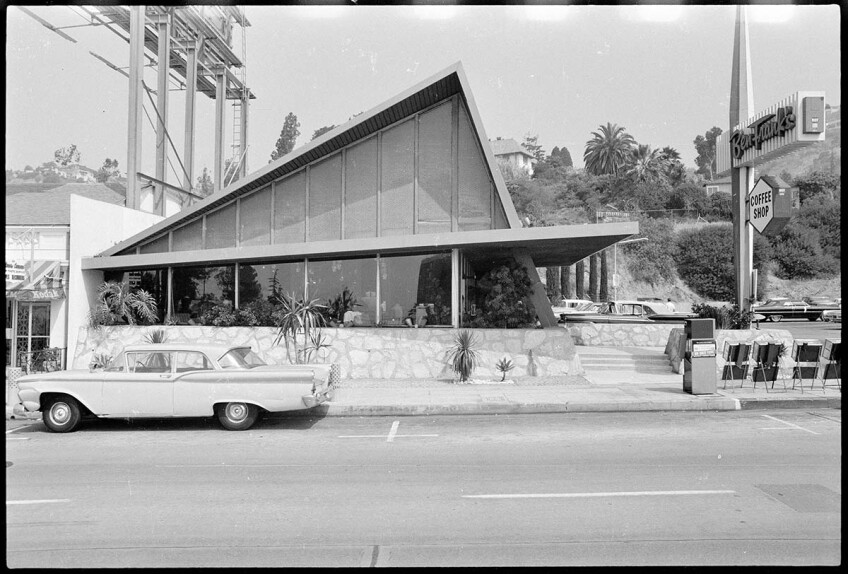Time Travel Through More than a Decade of Change on Sunset Boulevard with Ed Ruscha

With cabin fever getting the best of us, there’s no better time to visit the past than the present. And for a trip down memory lane, there’s no better site than the Getty’s “12 Sunsets,” an online project offering 12 different years of artist Ed Ruscha’s photographs of each building on Sunset Boulevard spanning 1966-2007. Users can hop in a pickup truck just like Ruscha’s, choose a year and drive down the boulevard and into a bygone era with photos of both sides of the street unfurling top and bottom.
“I love seeing what movies were playing in theaters and what bands were playing on the marquis,” says Andrew Perchuk, deputy director of GRI (Getty Research Institute), which compiled the project from Ruscha’s “Streets of Los Angeles” archive of over a half million images and growing. “One of my absolute favorites is Tower Records. You can see Sunset before Tower Records existed, you see it at its height and then you can see the very sad demise of it in the later period.”
The archive, bequeathed to GRI in 2012, includes several hundred thousand images, hundreds of contact sheets, and the resources for Ruscha’s seminal book, “Every Building on the Sunset Strip” (1966). His homemade rig at the time was a Nikon on a tripod with a motorized drive. Mounted in the back of his magenta pickup truck, it could capture over a thousand images on a single roll of 35 mm motion picture film.

“They're still images, but they were wound like motion picture reels. We got these giant film canisters as if we just got in ‘Lawrence of Arabia’ or something,” Perchuk recalls, noting that roughly 90% of the images are available to the public for the first time.
The archive includes subjects like Melrose Avenue, Beverly Boulevard and Third Street, but GRI only digitized images of streets the artist photographed more than once, like Sunset. Before settling in a bright, airy space on Western Avenue in Hollywood from 1965 to 1985, Ruscha moved from one studio space to the next in Eastside locales like Echo Park, Eagle Rock and the wilds of Pasadena.
It was around the time he produced some of his most iconic works like “Los Angeles County Museum of Art on Fire” and “Burning Gas Station,” though he was also quietly producing black-and-white photo books shot in straight ahead ‘no style,’ with little or no accompanying text. They include “Twentysix Gasoline Stations,” “Some Los Angeles Apartments,” and the aforementioned “Every Building on the Sunset Strip.”
Find more photos of Sunset Strip taken by Ed Ruscha. Click left and right:


















Since it is rare for an artist to document a city’s major thoroughfare over decades of change, “12 Sunsets” is valuable beyond its artistic purpose. Researchers can go building by building and chart the variety of businesses. “For instance, as cars get much more efficient, there are fewer gas stations on Sunset,” observes Perchuk. “We have film historians who are looking at how Ed photographed streets in L.A. versus how those streets are represented in movies from the era. We have a music historian who is going to connect the photos to individual songs, and also trace out musical changes on Sunset over time.”
The latter is looking at places like the Hollywood Palladium, which opened in 1940 with Frank Sinatra fronting the Tommy Dorsey Band. Fifteen years later it became the city’s focal point for Latin music. Martin Luther King gave a famous speech there in 1965, nine days before Selma. By the late sixties, Jimi Hendrix and Led Zeppelin were on the marquis.
Among all the things “12 Sunsets” is to art lovers and scholars, it is also the story of a place. But is it a happy or a sad story? Of course it is both.
“The sad story is the loss of many landmarks. Pandora's Box, the nightclub that was the center of teen culture in the sixties, and was the place where the Sunset Strip riots started, it's gone,” Perchuk laments. On the other hand, there’s the name change to the section of Sunset in downtown, now Cesar Chavez Boulevard, as well as the emergence of Little Armenia, Thai Town, and West Hollywood as a vibrant gay community. “The happy story is seeing the beginning of really visible diversity in L.A.”
Top Image: Screenshot of 12Sunsets.Getty.edu. All images © Ed Ruscha. Used with permission.




